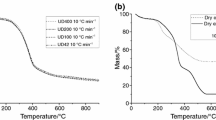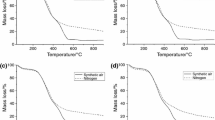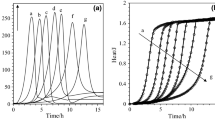Abstract
Annona muricata L., Annonaceae, popularly known as soursop, has anticancer and antidiabetic pharmacological properties. This work aims the characterization by thermoanalytical technique and determination of antimicrobial activity of different A. muricata L. leaves particle sizes. The leaves were dried, knifed, and separated by particle size. Samples were characterized by scanning electron microscopy (SEM) and thermogravimetry (TG) using the Ozawa kinetics model in two atmospheres (nitrogen and synthetic air). The antimicrobial activity and minimum inhibitory concentration of infusions were performed by the broth microdilution method to Escherichia coli, Staphylococcus aureus, Pseudomonas aeruginosa, and Klebsiella pneumoniae. SEM analysis suggests heterogeneous distribution in the observed particle sizes. TG curves were able to differentiate the degradation events and the residue contents in the samples analyzed in the nitrogen and synthetic air atmospheres. In nitrogen atmosphere curves, the different particle sizes presented four mass loss events, and residue ranged from 20.90 to 26.80% at the end of the analysis. In synthetic air atmosphere, the different particle sizes presented three mass loss events, and residue ranged from 7.80 to 10.42%. Ozawa model showed reaction order equal to zero for all samples assayed, and the activation energy (Ea) ranged from 121.36 to 135.42 and 115.50 to 141.00 kJ mol−1 for the nitrogen and synthetic air atmospheres, respectively. Antibacterial activity was confirmed for all particle sizes, in special to AM4 with S. aureus, E. coli, and K. pneumoniae. These results indicate that leaves from A. muricata L. have great potential for a variety of medicinal applications.




Similar content being viewed by others
References
Gavamukulya Y, Wamunyokoli F, El-Shemy HA. Annona muricata: is the natural therapy to most disease conditions including cancer growing in our backyard? A systematic review of its research history and future prospects. Asian Pac J Trop Med. 2017;10:835–48.
Gavamukulya Y, Abou-Elella F, Wamunyokoli F, et al. Phytochemical screening, anti-oxidant activity and in vitro anticancer potential of ethanolic and water leaves extracts of Annona muricata (Graviola). Asian Pac J Trop Med. 2014;7:355–63.
George VC, Kumar DR, Rajkumar V, et al. Quantitative assessment of the relative antineoplastic potential of the n-butanolic leaf extract of Annona muricata Linn. in normal and immortalized human cell lines. Asian Pac J Cancer Prev. 2012;13:699–704.
Bento EB, Matias EF, Brito FE Jr, et al. Association between food and drugs: antimicrobial and synergistic activity of Annona muricata L. Int J Food Prop. 2013;16:738–44.
Boyom FF, Fokou PVT, Yamthe LRT, et al. Potent antiplasmodial extracts from Cameroonian Annonaceae. J Ethnopharmacol. 2011;134:717–24.
Arthur FK, Larbie C, Woode E, et al. Evaluation of hepatoprotective effect of aqueous extract of Annona muricata (Linn.) leaf against carbon tetrachloride and acetaminophen-induced liver damage. J Nat Pharm. 2012;3:25–30.
Florence NT, Benoit MZ, Jonas K, et al. Antidiabetic and antioxidant effects of Annona muricata (Annonaceae), aqueous extract on streptozotocin-induced diabetic rats. J Ethnopharmacol. 2014;151:784–90.
Correa J, Ortiz D, Larrahondo J, Sanchez M, et al. Actividad antioxidante en guanábana (Annona muricata l.): una revisión bibliográfica. Bol Latinoam Caribe Plantas Med Aromát. 2012;11:111–26.
Nawwar M, Ayoub N, Hussein S, et al. Flavonol triglycoside and investigation of the antioxidant and cell stimulating activities of Annona muricata Linn. Arch Pharmacal Res. 2012;35:761–7.
Moghadamtousi SZ, Fadaeinasab M, Nikzad S, et al. Annona muricata (Annonaceae): a review of its traditional uses, isolated acetogenins and biological activities. Int J Mol Sci. 2015;16:15625–58.
Coria-Tellez AV, Montalvo-Gónzalez E, Yahia EM, et al. Annona muricata: a comprehensive review on its traditional medicinal uses, phytochemicals, pharmacological activities, mechanisms of action and toxicity. Arab J Chem. 2016;11:662–91.
Wahab A, Mariam S, Jantan I, Haque M, Arshad L. Exploring the leaves of Annona muricata L. as a source of potential anti-inflammatory and anticancer agents. Front Pharmacol. 2018;9:661. https://doi.org/10.3389/fphar.2018.00661.
Quílez AM, Fernández-Arche MA, García-Giménez MD, De la Puerta R. Potential therapeutic applications of the genus Annona Local and traditional uses and pharmacology. J Ethnopharmacol. 2018;25:244–70.
Yuan SSF, Chang HL, Chen HW, Yeh YT, Kao YH, Lin KH, Su JH. Annonacin, a mono-tetrahydrofuran acetogenin, arrests cancer cells at the G1 phase and causes cytotoxicity in a Bax-and caspase-3-related pathway. Life Sci. 2003;72(25):2853–61. https://doi.org/10.1016/S0024-3205(03)00190-5.
Correia LP, Procópio JVV, Santana CP, et al. Herbal medicine physical quality evaluation by thermal analysis using adapted Ozawa method. J Therm Anal Calorim. 2015;122:207–14. https://doi.org/10.1007/s10973-015-4638-5.
Cardoso IC, Pereira HMG, Tappin MRR, et al. Influência da técnica de extração e do tamanho de partícula do material vegetal no teor de compostos fenólicos totais da tintura das folhas de Alpinia zerumbet. Rev Fitos. 2017;11:62–8.
Correia LP, Procópio JVV, de Santana CP, et al. Characterization of herbal medicine with different particle sizes using pyrolysis GC/MS, SEM, and thermal techniques. J Therm Anal Calorim. 2013;111:1691–8. https://doi.org/10.1007/s10973-011-2129-x.
Santana CP, Medeiros FD, Correia LP, Diniz PHGD, Véras G, Medeiros ACD. Dissolution and uniformity of content of tablets developed with extract of Ximenia americana L. PLoS ONE. 2018;13(5):e0197323. https://doi.org/10.1371/journal.pone.0197323.
Ekere KE, Isimi YC, Okoh JE, Olobayo KO, Emeje MO. Differential scanning calorimetry and thin layer chromatography: emerging tools for predicting stability of herbal products. J Herb Med. 2017;9:74–80.
de Lima Ramos Júnior FJ, da Silva KMA, Brandão DO, et al. Investigation of the thermal behavior of inclusion complexes with antifungal activity. J Therm Anal Calorim. 2018;133:641–8. https://doi.org/10.1007/s10973-018-7040-2.
Lavor EP, Navarro MVM, Freire FD, et al. Application of thermal analysis to the study of antituberculosis drugs–excipient compatibility. J Therm Anal Calorim. 2014;115:2303–9. https://doi.org/10.1007/s10973-013-3050-2.
Galvão FP, De Brito WA, Dantas MG, et al. Thermal characterization of some guanylhydrazones by thermal and nonthermal techniques. J Therm Anal Calorim. 2015;120:879–87. https://doi.org/10.1007/s10973-014-4332-z.
Chaves TP, Fernandes FHA, Santana CP, et al. Evaluation of the interaction between the Poincianella pyramidalis (Tul.) LP Queiroz extract and antimicrobials using biological and analytical models. PloS One. 2016;11:1–23. https://doi.org/10.1371/journal.pone.0155532.
Correia LP, de Santana CP, da Silva KMA, et al. Physical and chemical characteristics of Maytenus rigida in different particle sizes using SEM/EDS, TG/DTA and pyrolysis GC–MS. J Therm Anal Calorim. 2018;131:743–52. https://doi.org/10.1007/s10973-016-5999-0.
Correia LP, Santana CP, Medeiros ACD, et al. Sideroxylon obtusifolium herbal medicine characterization using pyrolysis GC/MS, SEM and different thermoanalytical techniques. J Therm Anal Calorim. 2016;123:993–1001. https://doi.org/10.1007/s10973-015-4986-1.
Guimarães GP, Santos RL, Brandão DO, et al. Thermoanalytical characterization of herbal drugs from Poincianella pyramidalis in different particle sizes. J Therm Anal Calorim. 2018;131:661–70. https://doi.org/10.1007/s10973-016-6076-4.
Cuinica LG, Macêdo RO. Thermoanalytical characterization of plant drug and extract of Urtica dioica L. and kinetic parameters analysis. J Therm Anal Calorim. 2018;133:591–602. https://doi.org/10.1007/s10973-018-6986-4.
Smith RE, Tran K, Richards KM. Bioactive annonaceous acetogenins. In: ur Rahman A, editor. Studies in natural products chemistry, vol. 41. Amsterdam: Elsevier; 2014. p. 95–117. https://doi.org/10.1016/B978-0-444-63294-4.00004-8.
Brandão DO, Guimarães GP, Santos RL, et al. Model analytical development for physical, chemical, and biological characterization of Momordica charantia vegetable drug. J Anal Methods Chem. 2016;2016:1–15. https://doi.org/10.1155/2016/7528297.
Fernandes FHA, Boylan F, Salgado HRN. Quality standardization of herbal medicines of Spondias dulcis Parkinson using analytical and microbiological analysis. J Therm Anal Calorim. 2018. https://doi.org/10.1007/s10973-018-7486-2.
da Costa RS, Negrão CAB, Camelo SRP, et al. Investigation of thermal behavior of Heliotropiumindicum L. lyophilized extract by TG and DSC. J Therm Anal Calorim. 2013;111:1959–64. https://doi.org/10.1007/s10973-011-2088-2.
Radji M, Kurniati M, Kiranasari A. Comparative antimycobacterial activity of some Indonesian medicinal plants against multi-drug resistant Mycobacterium tuberculosis. J Appl Pharm Sci. 2015;5:19–22.
Van de Venter M, Pruissen M, Koekemoer T. In vitro anti-HIV and-TB activities of Annona muricata and Artemisia afra extracts. Planta Med. 2014;80:1–29.
Valle AC, Gabas G, Gabriel N, et al. Ethanol extract of plants from biome’cerrado’active against bacteria related to respiratory disease in pets. Planta Med. 2014;80:1–15.
Takahashi JA, Pereira CR, Pimenta LP, et al. Antibacterial activity of eight Brazilian Annonaceae plants. Nat Prod Res. 2006;20:21–6.
Kostova I, Dinchev D. Saponins in Tribulus terrestris—chemistry and bioactivity. Phytochem Rev. 2005;4:111–37.
Viera GHF, Mourão JA, Ângelo ÂM, et al. Antibacterial effect (in vitro) of Moringa oleifera and Annona muricata against Gram positive and Gram negative bacteria. Rev Inst Med Trop São Paulo. 2010;52:129–32.
Author information
Authors and Affiliations
Corresponding author
Additional information
Publisher's Note
Springer Nature remains neutral with regard to jurisdictional claims in published maps and institutional affiliations.
Rights and permissions
About this article
Cite this article
de Andrade, F.H.D., de Araújo Batista, R.S., Lins, T.B. et al. Thermal characterization and microbiology assay of Annona muricata L. leaves. J Therm Anal Calorim 138, 3737–3745 (2019). https://doi.org/10.1007/s10973-019-08050-w
Received:
Accepted:
Published:
Issue Date:
DOI: https://doi.org/10.1007/s10973-019-08050-w




